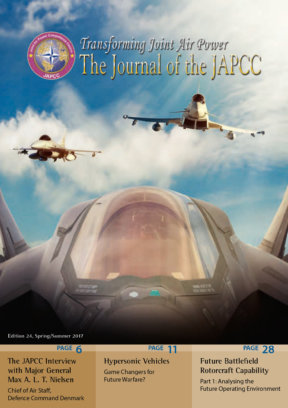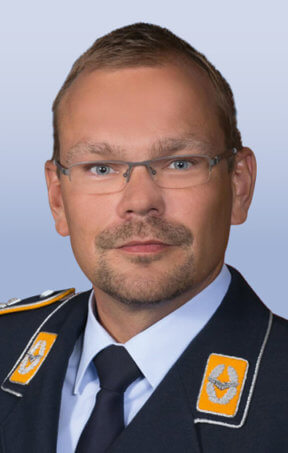History
On 3 December 1999, the Extended Air Defence Task Force (EADTF) was installed in Burbach, Germany. At that time, the mission spectrum for Ground Based Air Defence (GBAD) forces had expanded to include the defence against Ballistic and Cruise Missiles. The only GBAD weapon system that could deal with this broader threat was the PATRIOT system, so the three user nations became the EADTF founding members.
The EADTF was designed as a small, flexible organization, made up of 34 German, Dutch, and US soldiers. Its original mission was twofold. In peacetime, the Task Force was to enhance planning and coordinating of combined air defence activities, including training, exercises, and interoperability tests. The goal was to satisfy requirements for more interoperability between the nations and to develop common training, tactics, and procedures (TTPs). Additionally, the need emerged to embed the ‘new’ capability into the NATO Integrated Air Defence System (NATINADS) and to provide Theatre Missile Defence (TMD) for out-of-area missions. Thus, this new Task Force also received a distinct operational role and was set up to enable or assume mission-related command and control functions for AD/TMD organizations. During Operation DISPLAY DETERRENCE in 2003, US and Dutch EADTF personnel accomplished the first operational assignment by providing guidance and support to enhance NATINADS in the defence of Turkish territory.
Due to major restructuring and base closures within the German Air Force in 2004, and the US withdrawal from the Task Force in 2008, the EADTF eventually moved into the current facilities of NATO Allied Air Command (AIRCOM) headquarters, located at Ramstein Air Base. Reassessing the value of the EADTF, the remaining member nations decided to continue the successful cooperation. Subsequently, the EADTF became one of the flagship examples of intensified bilateral military cooperation between Germany and the Netherlands.
In the following years, the proliferation of ballistic missiles became a major concern for NATO and its member nations. By then, the EADTF was ready to answer the call for providing in-depth operational and technical expertise in this specific area. It supported NATO in developing software prototypes as well as operationalizing the Active Layered Theatre Ballistic Missile Defence (ALTBMD) Interim Capability for planning and executing of the (T)BMD mission.
In its Strategic Concept 2010 and subsequent summit communiqués, NATO reiterated the prioritized commitment to build a substantial, integrated, and interoperable (T)BMD capability. With NATO’s decision to build organic, interoperable, and standardized C2 resources and procedures (BMC3I), the EADTF succeeded in its original mission while still supporting the NATO Command Structure in furthering and sustaining this new capability.
CC SBAMD and the EADTF Legacy
Whilst the EADTF had a significant reputation for its operational value and subject matter expertise in (T)BMD, the implementation of Integrated Air and Missile Defence (IAMD) concepts by NATO Allies called for respective high-level expertise and capabilities. Acknowledging this requirement, in December 2012 the German-Dutch General Officers Steering Committee (GOSC) initiated the transformation into the Competence Centre for Surface Based Air and Missile Defence (CC SBAMD). Since then, the new, more generic mission has been to provide premier operational level expertise as well as operational and training capabilities in the field of Surface Based Air and Missile Defence. Today, the CC SBAMD staff is comprised of 18 highly trained and experienced personnel from Germany and the Netherlands, while the Commander and Chief of Staff positions rotate between the two nations. The relevance of a joint approach in contemporary IAMD operations is underscored by voluntary representation of both nation’s navies within the Centre.
The CC SBAMD is neither part of the NATO Command Structure nor the NATO Integrated Air and Missile Defence System (NATINAMDS). It can, however, support and reinforce existing NATO Headquarters or assist or command a multi-national Task Force. Because of this, the CC SBAMD is a small but crucial element in support of NATO’s Smart Defence and the development of the Framework Nation Concept’s AMD cluster.
Furthermore, the CCSBAMD is one of the building blocks of German-Dutch military cooperation. It has close ties with the German-Dutch APOLLO project, which promotes SBAMD cooperation at the tactical level, but is not intended to become an elite bi-national SBAMD think tank. Rather, other nations with respective SBAMD (including (T)BMD) capabilities are invited to contribute in a liaising role or even as a permanent member of the Centre.
CC SBAMD Vision and Policy
For historical reasons, (T)BMD will for now remain the CC SBAMD’s main field of expertise within the AMD arena, but the scope is broadening. In the light of the increasing relevance of the threats posed by Cruise Missiles (CM), Anti-Radiation Missiles (ARM), Unmanned Aerial Systems (UAS), and Aircraft, the CC SBAMD will continue to focus on a wider range of issues regarding the integration of Joint and Combined SBAMD capabilities and forces.
Based on current capabilities, threats and near-future trends, the GOSC and the respective staffs are developing the CC SBAMD’s annual programme of work with prioritized activities that can be summarized into four categories. These categories are inherently overlapping and interlocking, and consequently, the different activities will have multiple effects as they serve to provide first class advice to all partners and stakeholders while at the same time preserving leading levels of expertise within the organization.
1. Planning and Execution of (T)BMD Missions. The CC SBAMD can provide up to three teams that will be qualified for both (T)BMD planning and mission execution. Based on military requirements, these teams are capable of planning Command and Control (C2) structures, Air & Missile Defence (AMD) sensors, and weapon systems at the operational and tactical level. Furthermore, these teams are also capable of executing operations in NATO’s defence against air and missile threats whilst utilizing modern NATO BMC3I systems.
When NATO enhanced its defensive posture for ACTIVE FENCE TURKEY (AF TUR) in 2013, the EADTF not only provided planning expertise for developing the initial defence design and dedicated training for deploying troops, but also provided significant personnel support to sustain HQ AIRCOM’s BMD mission. For about one year, up to two crews were permanently assigned to NATO in order to sustain the manning of the BMD Operations Centre. Even today, CC SBAMD personnel are regularly transferred to NATO as a Voluntary National Contribution (VNC) in order to support the BMD mission of the HQ AIRCOM’s Ballistic Missile Defence Operations Centre (BMDOC). With this direct support to NATO’s peacetime BMD mission, CC SBAMD contributes its special expertise while remaining qualified in the field of the BMD mission execution.
2. Providing AMD Expertise. The EADTF gained a level of expertise and knowledge to support NATO (HQ, SHAPE and HQ AIRCOM) in developing AMD policy and doctrine, concepts, plans, and other AMD-related documentation. The CC SBAMD will conserve the expertise and continue to stand by to give substantial advice to the NATO Command Structure if required. Although currently only bi-nationally sourced, the Competence Centre supports NATO in the development of IAMD capabilities and C2 systems (e.g. ACCS and AIRC2IS) from an operational user perspective. The same expertise also enables the CC SBAMD to contribute to the respective national Air and Missile Defence decision-making processes. Working closely with both the national decision-making and NATO entities at all relevant levels will ensure the Competence Centre maintains a high level of expertise. To this respect, close cooperation will continue to have mutual benefits for all stakeholders in the field of SBAMD.
3. Education and Training of AMD Personnel. It is in the interest of the Competence Centre to promote the subject of SBAMD to a wider audience to create more visibility and awareness. Thus, it is of utmost relevance to create opportunities for vivid discussions and education in the field of IAMD. The CC SBAMD approach to cater to this requirement is twofold. First, it hosts the internationally renowned ‘Air and Missile Defence Conference’ that is unique in its particular focus. While covering current trends and issues in the field of IAMD at the operational and strategic level, its target audience deliberately includes the tactical operator (down to unit level) to spur mutual understanding and exchange. Second, the CC SBAMD programme of work includes the provision of dedicated training opportunities within its very expertise domain – at no cost. There are two venues available. The CC SBAMD ‘Advanced Air and Missile Defence Course’ is a semi-annually hosted, one-week, in-house event to provide education in the field of NATO Integrated Air and Missile Defence to functional area personnel from (multi)national HQs. Further, the Competence Centre provides 1–2 day ‘Focus Seminars’ at NATO and member nations’ entities tailored to their special requirements, including senior leadership training.
4. Multinational Cooperation. The former EADTF and the current CC SBAMD have gained experience and expertise in multi-national cooperation through a number of NATO-centric and multi-national exercises (Nimble Titan, Joint Project Optic Windmill/Joint Project Optic Alliance) as well as during more delicate projects e.g. within the framework of the NATO – Russia Council. This level of involvement qualifies the CC SBAMD to assume prominent roles in co-operative efforts, including its assistance to the NATO Air and Missile Defence Committee as well as the Panel on Air and Missile Defence. Further, reaching out to science and research entities, including contacts to national armament research as well as NATO agencies and other competence centres (e.g. JAPCC), provides insight into future trends in the IAMD domain. In that capacity, the CC SBAMD contributes to the development of future NATO BMC3I systems.
Summary
The CC SBAMD is a relatively small entity, but tailored, organized, and equipped to render a unique capability for Germany and The Netherlands as well as NATO and international partners. It continues to accomplish its mission by connecting to the network of external expertise, using long standing liaison connections, and linking to science and research. Today, the CC SBAMD maintains an immense knowledge repository for the benefit of its member nations, the NATO Alliance, the EU and other international entities.
The knowledge and expertise of the Competence Centre will contribute further to emerging European AMD capabilities, and will have a significant benefit for all participating nations and stakeholders. The CC SBAMD will maintain the EADTF legacy and capabilities in the fields of operations, concept development, experimentation, intelligence, coordination, and education and training. The small personnel footprint, however, mandates the efficient use of resources. By putting a smart focus on current topics and future trends in the field of Air and Missile Defence, the CC SBAMD will remain the prime partner for Surface Based Air and Missile Defence at the tactical, operational, strategic, and policy level.












